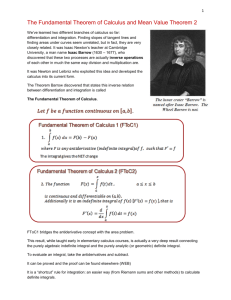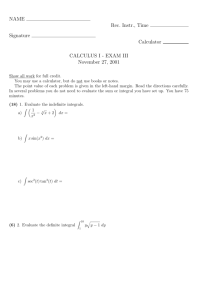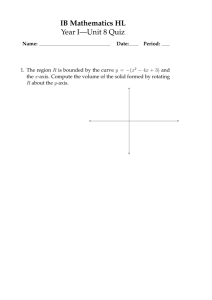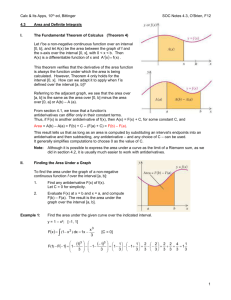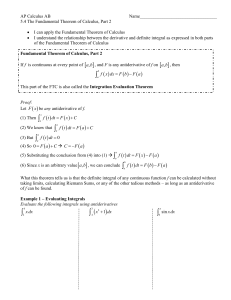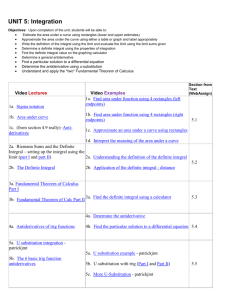Definite Integrals. Fundamental Theorem of Calculus
advertisement
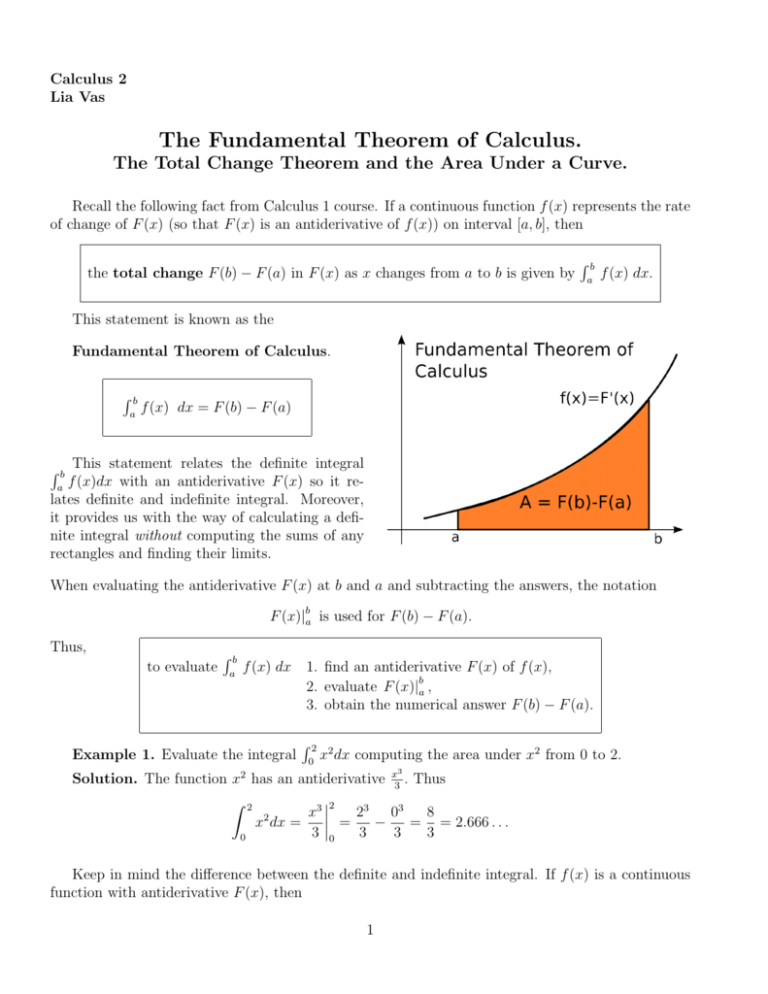
Calculus 2 Lia Vas The Fundamental Theorem of Calculus. The Total Change Theorem and the Area Under a Curve. Recall the following fact from Calculus 1 course. If a continuous function f (x) represents the rate of change of F (x) (so that F (x) is an antiderivative of f (x)) on interval [a, b], then the total change F (b) − F (a) in F (x) as x changes from a to b is given by Rb a f (x) dx. This statement is known as the Fundamental Theorem of Calculus. Rb a f (x) dx = F (b) − F (a) R b This statement relates the definite integral f (x)dx with an antiderivative F (x) so it rea lates definite and indefinite integral. Moreover, it provides us with the way of calculating a definite integral without computing the sums of any rectangles and finding their limits. When evaluating the antiderivative F (x) at b and a and subtracting the answers, the notation F (x)|ba is used for F (b) − F (a). Thus, to evaluate Rb a f (x) dx Example 1. Evaluate the integral 1. find an antiderivative F (x) of f (x), 2. evaluate F (x)|ba , 3. obtain the numerical answer F (b) − F (a). R2 0 x2 dx computing the area under x2 from 0 to 2. 3 Solution. The function x2 has an antiderivative x3 . Thus 2 Z 2 8 x3 23 03 2 x dx = = − = = 2.666 . . . 3 0 3 3 3 0 Keep in mind the difference between the definite and indefinite integral. If f (x) is a continuous function with antiderivative F (x), then 1 the indefinite integral R f (x) dx the definite integral Rb f (x) dx a is the family of functions F (x) + c, is the number F (b) − F (a). The fact that the Fundamental Theorem of Calculus enables you to compute the total change in antiderivative of f (x) when x changes from a to b is referred also as the Total Change Theorem. Thus, the definite integral can be used to find the total change in a quantity on an interval given its rate. Example 2. Suppose that the velocity of an object is given by the function v(t) = 0.3t where t is the time in seconds and v is the velocity in feet per second. Determine the total movement of the object between 10 and 20 seconds. Solution. The total movement is the total change in position s(t) from 10 to 30 seconds is s(20) − s(10). This can be found as the definite integral from 10 to 20 of the rate v(t) = s0 (t). Thus, 20 Z 20 Z 20 1 2 0.3t dt = 0.3 t = 0.15(202 − 102 ) = 0.15(300) = 45 feet. v(t) dt = s(20) − s(10) = 2 10 10 10 Units of the total change. If [x] denotes the units of quantity x and [f (x)] denotes the units of f (x), Rb the definite integral a f (x)dx is in units [f (x)] · [x]. For instance, in Example 2 above, the units of the definite integral are the units of velocity multiplied by the units of time. Thus, the answer is in meters since the product meters · second second produces meters. In some cases you may be instructed to use the calculator to approximate the definite integral. Example 3. The size of a certain bacteria culture grows at a rate of f (t) = tet/2 milligrams per hour. Use the Left-Right Sums calculator program to approximate the bacteria size after the first 3 hours to first two nonzero digits. R3 Solutions. The bacteria size after the first 3 hours can be found as 0 tet/2 dt. Enter the function in your calculator as xex/2 , start the program and enter that a = 0, b = 3. With n = 300 for example, both the left and the right sums round to 13. Thus, in 3 hours the size increased by 13 mg. Recall also the following properties of the definite integral. Assume that f (x) is a continuous functions on [a, b] with antiderivatives F (x). Ra 1. a f (x) dx = F (a) − F (a) = 0 Rb Ra 2. a f (x) dx = F (b) − F (a) = −(F (a) − F (b)) = − b f (x) dx. Rb 3. If c is any number from [a, b], then a f (x) dx = F (b) − F (a) = F (b) − F (c) + F (c) − F (a) = Rc Rb (F (c) − F (a)) + (F (b) − F (c)) = a f (x) dx + c f (x) dx. This property can be shown to hold for any number c, not necessarily between a and b. 2 4. The variable name used in the definite integral does not matter. In other words, Rb Rb f (t) dt = f (u) du = . . . a a Rb a f (x) dx = Finding the area between f (x) and x-axis on a given interval. So far we related the definite integral and area under the graph of a continuous function just in the case the function is nonnegative. Recall that in this case the definite integral is exactly equal to the area. Let us consider now the other computing the area if the function is not nonnegative on entire interval. First, let us now consider the case when a given function is less or equal to zero on an interval [a, b]. If f (x) ≤ 0 then |f (x)| = −f (x) ≥ 0 and the size of the area A between x-axis and f (x) on [a, b] is the same as the size of the area under the curve of |f (x)| = −f (x) on [a, b]. Thus Z b Z b −f (x)dx = − A= f (x)dx a a R b We can unify the cases f (x) ≥ 0 or f (x) ≤ 0 by writing that in either case a |f (x)| dx = a f (x) dx but note that this does not have to hold if the function f (x) changes sign on interval [a, b]. Let us assume that f (x) is changing the sign just once at c in [a, b]. Say that f is changing from negative to positive at c as in the figure below. Rb On interval [a, c], f (x) ≤ 0 so the area A1 between f (x) and x-axis can be found as A1 = Rc − a f (x) dx. On interval [c, b], f (x) ≥ 0 so the area A2 between f (x) and x-axis can be found Rb as A2 = c f (x) dx. The total area A can be obtained as the sum A1 + A2 . Thus Z c Z −f (x)dx + A = A1 + A2 = a b f (x)dx. c Note that the total area cannot be evaluated using a single definite integral. The property 3. does not apply to the sums of two integrals in the last formula since the integrand in the first integral is −f (x) and the integrand in the second integral is f (x). Similarly, if f is changing from positive to negative at c in [a, b] we would have that A = A1 +A2 = Rc Rb f (x)dx + c −f (x)dx. a If f (x) has more than one x-intercept in [a, b], one would need to divide the total area in more than two regions. 3 This brings us to the following procedure for finding the total area under the curve. Finding Area. To find the total area A between the graph of a continuous function f (x) and x-axis on [a, b], 1. Graph the function on [a,b] and check if f is positive, negative or it changes the sign. 2. Consider the following cases. Rb Case 1. If f is positive on [a, b], then A = a f (x) dx. Rb Case 2. If f is negative on [a, b], then A = a −f (x) dx. Case 3. If f is changing sign on [a, b] proceed with the following steps. 3. Find all x-intercepts c1 , c2 . . . ck of f (x) which are in [a, b] and divide the interval into subintervals such that f does not change sign on each subinterval. 4. Finding the area between f and x-axis on each subinterval falls under either case 1 or 2. 5. The total area A is the sum of the areas on each subinterval. Example 4. Find the area between the graph of f (x) = 4 − x2 and x-axis on [0, 3]. Solution. Consider the graph of the function on the interval [0,3]. Note that function changes the sign from positive to negative at a point between 0 and 3. Set the function to zero to find the x-intercepts. 4 − x2 = 0 ⇒ x2 = 4 ⇒ x = ±2. Since -2 is not in [0,3], just 2 is relevant. Let A1 denote the area on [0,2] and A2 the area on [2,3]. The function is positive on [0,2) and negative on (2,3] so Z 2 Z 3 Z 3 2 2 A1 = (4 − x )dx and A2 = −(4 − x )dx = − (4 − x2 )dx. 0 2 2 Find the antiderivative 4x − 13 x3 of 4 − x2 and evaluate the two areas as follows. 2 Z 2 1 3 1 1 8 16 2 A1 = (4 − x )dx = (4x − x ) = (4(2) − 23 ) − (4(0) − 03 ) = 8 − = . 3 3 3 3 3 0 0 3 Z 3 1 3 1 3 1 3 8 7 2 A2 = − (4−x )dx = − (4x − x ) = − (4(3) − 3 ) − (4(2) − 2 ) = −(12−9−8+ ) = . 3 3 3 3 3 2 2 Thus the total area A is A = A1 + A2 = 16 3 + 7 3 Practice Problems. 4 = 23 3 ≈ 7.67. 1. Evaluate the following. (a) R2 0 2x dx (b) R1 0 x2 + 2 dx (c) R4 1 x−2 dx 2. Find the area between the graph of f (x) and x-axis on [a, b]. (a) f (x) = x2 ; a = 0, (b) f (x) = x − 3; b = 2. (c) f (x) = x2 − 9; a = −1, b = 4 √ (e) f (x) = 2 x − 4; a = 0, b = 9 a = 1, (d) f (x) = x2 − 2x a = 1, b=2 b=3 3. From past records, a botanist knows that a certain species of tree has a rate of growth that can be modeled by f (t) = √2t , 1 ≤ t ≤ 4, where t is the age of the tree in years and f (t) is the growth rate in feet per year. Determine how much did the tree grow from the time when it was a year old to the time it was four years old. 4. Suppose that the velocity of an object is given by the function v(t) = √t2t+9 where t is the time in seconds and v is the velocity in feet per second. Determine the total movement of the object between 3 and 5 seconds. 5. The rate of change in the U.S. population can be modeled by g(x) = 1.03e0.013t , 0 ≤ t ≤ 100 where t represents the number of years since 1900 and g represents the rate of change in population measured in millions per year. Determine the total increase in the U.S. population from 1900 to 1950. Solutions. 2 R2 2 x2 1. (a) 0 2x dx = 2 2 = x2 |0 = 4 − 0 = 4. 0 1 R1 2 3 3 (b) 0 x + 2 dx = ( x3 + 2x) = 13 + 2(1) − 0 = 37 . 0 4 R 4 −2 −1 4 = −1 − −1 = 3 . (c) 1 x dx = x−1 = −1 x 1 4 1 4 1 2. (a) Since f (x) is positive on the given interval, the area is A = R2 0 x2 dx = 2 x3 3 0 = 83 . (b) Graph the function f (x) = x− 3 and note that it is negative on [1,2]. Thus, the area is R2 2 2 A = − 1 (x − 3)dx = −( x2 − 3x) = −2 + 6 + 21 − 3 = 1 + 12 = 32 . 1 (c) Graph the function and check the sign of f (x) on [-1,4]. Notice that f (x) changes the sign. Find x-intercepts: f (x) = x2 − 9 = 0 when x2 = 9 ⇒ x = ±3. The relevant zero is 3 since -3 is not in the interval [-1,4]. From the graph, you can see that f (x) is negativeR on [-1, 3) and 3 positive on (3, 4]. Thus, the total area can be obtained as the sum of A1 = − −1 f (x)dx and R4 A2 = 3 f (x)dx. 3 R4 2 R3 2 x3 = 26.67. A = (x − 9)dx = A1 = − −1 (x − 9)dx = (− 3 + 9x) = −9 + 27 − 13 + 9 = 80 2 3 3 −1 4 3 ( x3 − 9x) = 64 − 36 − 9 + 27 = 10 = 3.33 The total area is A = A1 + A2 = 80 + 10 = 30. 3 3 3 3 3 R4 Careful: the total area is not −1 f (x)dx = −23.33. 5 (d) Check the sign of f (x) on [1,3] and note that f (x) changes the sign. Find x-intercepts: f (x) = x2 − 2x = 0 ⇒ x(x − 2) = 0 ⇒ x = 0, x = 2. The relevant zero is 2 since 0 is not in the interval [1,3]. From the graph, you can see that f (x) is negative R 2 on [1, 2) and positive R 3 on (2, 3]. Thus, the total area can be obtained as the sum of A1 = − 1 f (x)dx and A2 = 2 f (x)dx. 2 R2 2 R3 x3 2 A1 = − 1 (x − 2x)dx = (− 3 + x ) = − 38 + 4 + 13 − 1 = 23 = 0.67. A2 = 2 (x2 − 2x)dx = 1 3 8 x3 4 2 ( 3 − x ) = 9 − 9 − 3 + 4 = 3 = 1.33 The total area is A = A1 + A2 = 32 + 43 = 2. 2 R3 Careful: the total area is not 1 f (x)dx = 0.67. (e) Check√the sign of f (x) on note that f (x) changes the sign. Find x-intercepts √ [0,9] and √ f (x) = 2 x − 4 = 0 when 2 x = 4 ⇒ x = 2 ⇒ x = 4. From the graph, you can see that f (x) is negative on [0, 9]. Thus, the total area can be obtained as the sum R 4 4) and positive on R(4, 9 of the area A1 = − 0 f (x)dx and A2 = 4 f (x)dx. Similarly as in previous problems, you can calculate that A1 = 16 = 5.33 and A2 = 16 = 5.33. The total area is A = A1 +A2 = 32 = 10.67. 3 3 3 R9 Careful: the total area is not 0 f (x)dx = 0. 4 R4 1/2 3. The total growth can be found by integrating the growth rate from 1 to 4. 1 √2t dt = 2 t1/2 = 1 √ 4 4 t 1 = 8 − 4 = 4 feet. R5 4. If s(t) denotes the distance traveled, the problem is asking for s(5) − s(3) = 3 v(t)dt. Using √ the substitution with u = t2 + 9 find the antiderivative of the velocity function to be t2 + 9. √ √ √ 5 Thus s(5) − s(3) = t2 + 93 = 34 − 18 ≈ 1.588 ft. R 50 5. The total increase in the number of people from t = 0 to t = 5− can be found as 0 1.03e0.013t dt. Use the substitution u = 0.013t to find the antiderivative and get 1 1.03 0.013t 50 1.03 0.013 e = 0.013 (e0.013(50) − 1) ≈ 79.23(0.916) = 72.54 millions. 0 6


